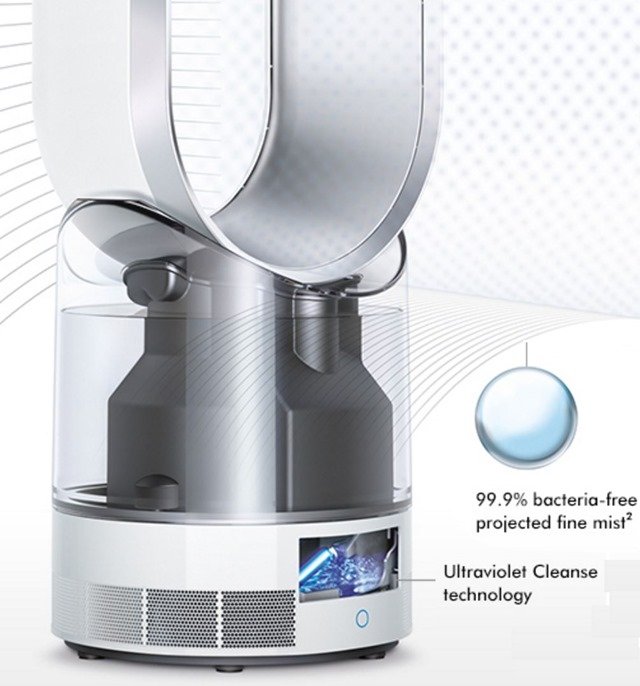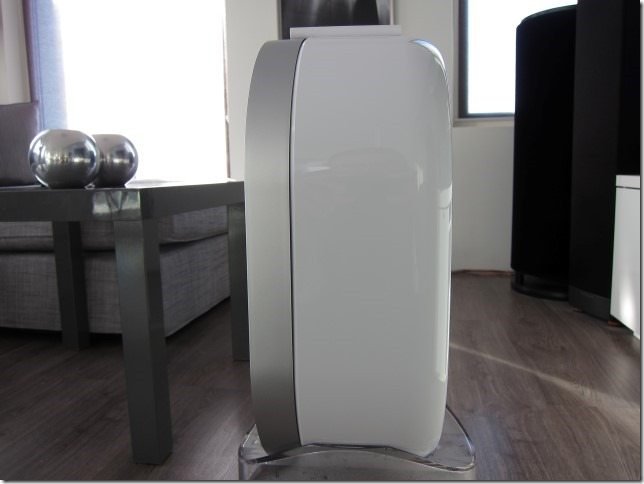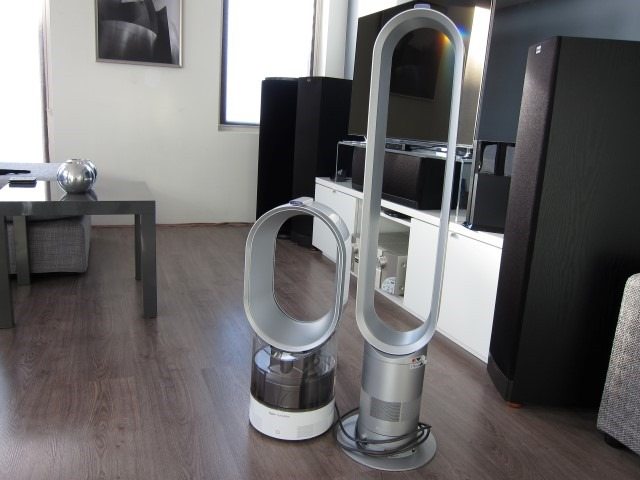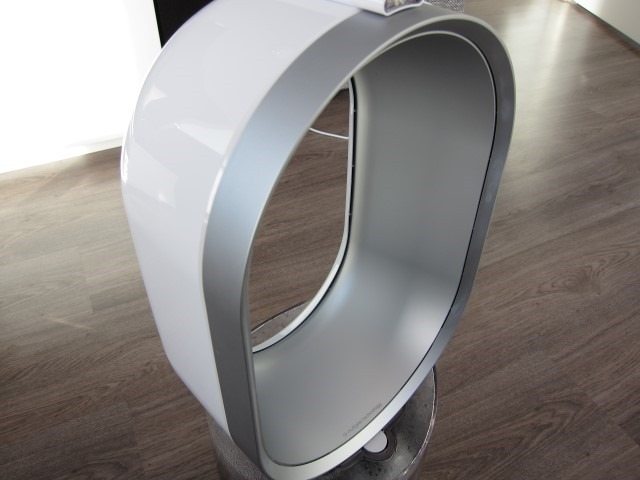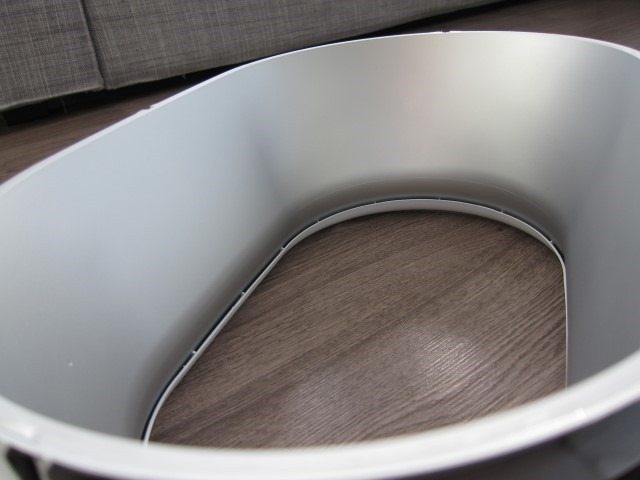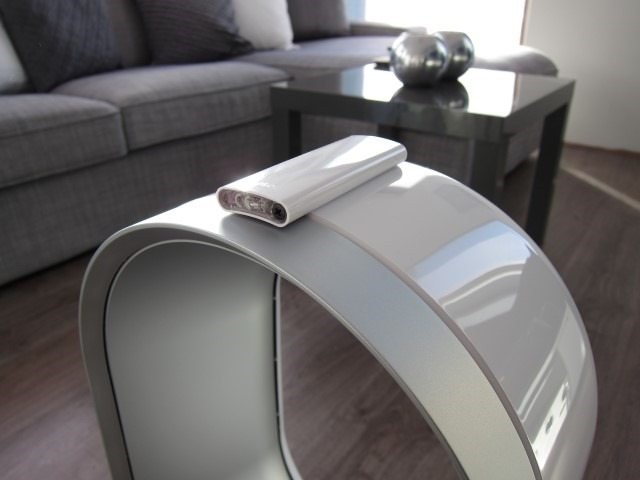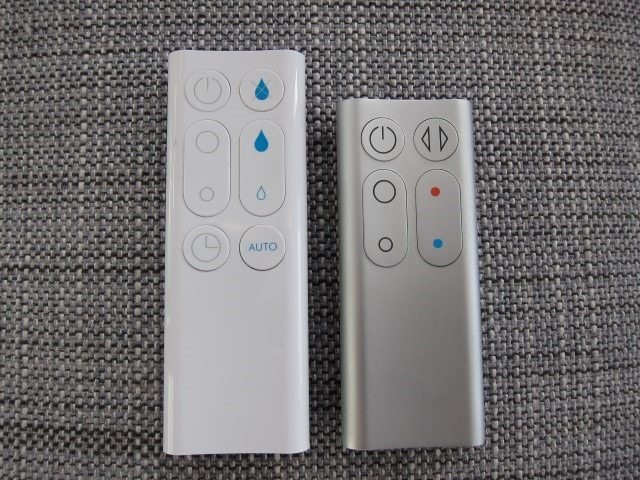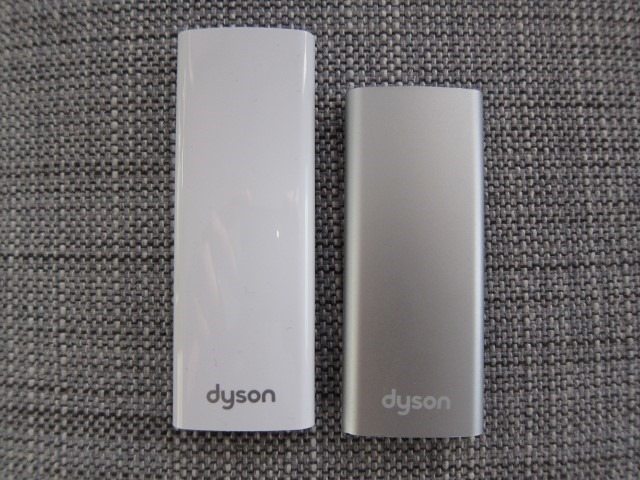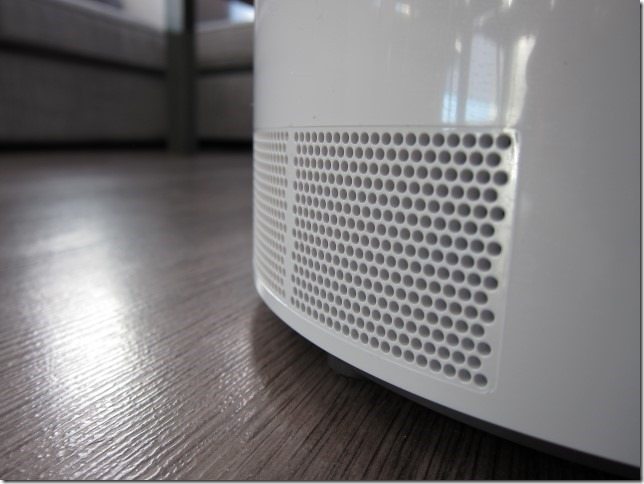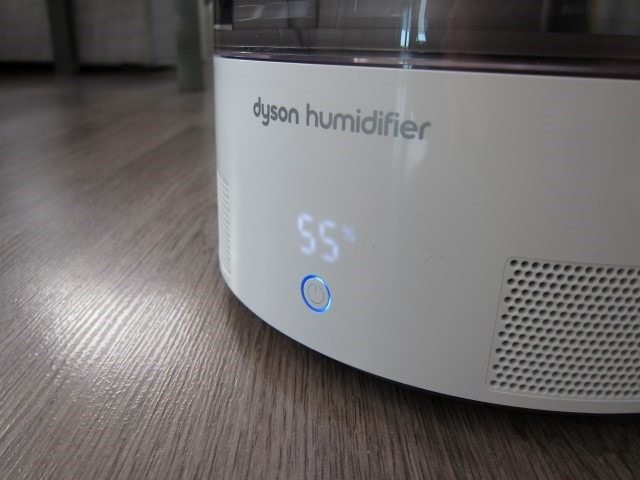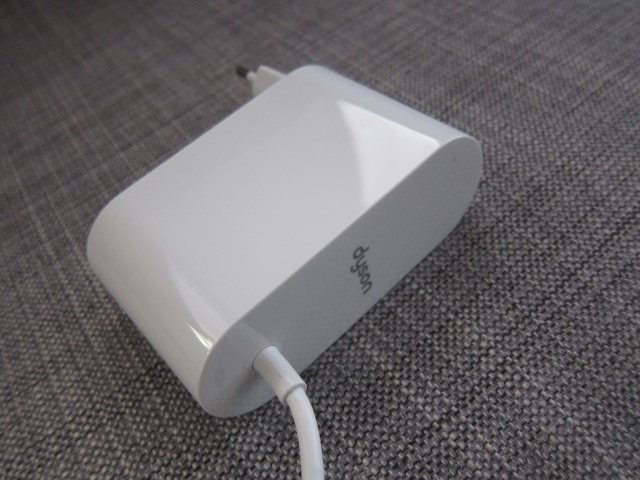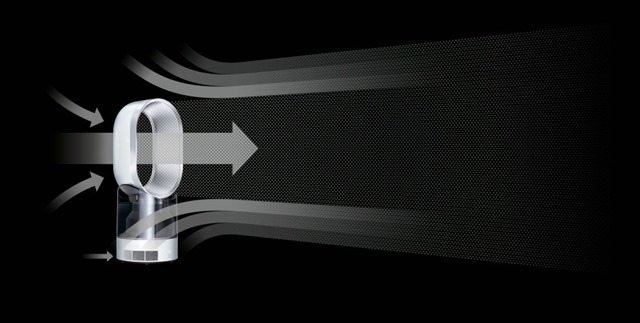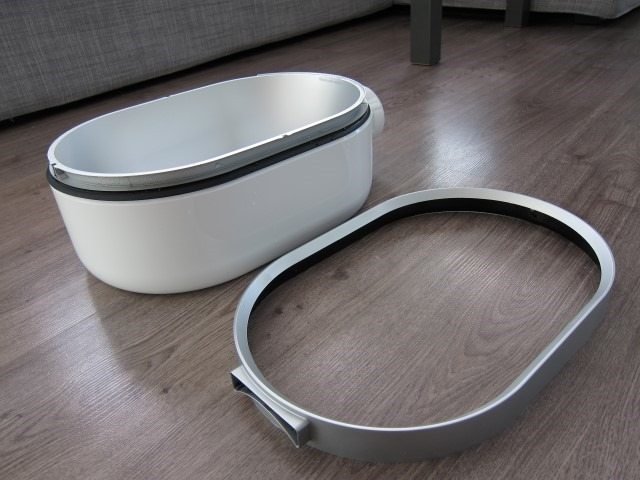Take a Dyson bladeless fan and combine it with a humidifier and the result is a hybrid in the form of the new Dyson Humidifier AM10. A hybrid because it’s first and foremost a humidifier (hence the “Humidifier” name), but with a twist of course, as they’ve managed to cram it into a Dyson fan, giving you in fact two products in one. But is this the case of another two-in-one that’s neither good at being a humidifier or a fan? This review is the result of having lived with the AM10 for 2 months.
Specifications
|
AM10 humidifier White/Silver |
· |
|
Air Amplification |
• Yes |
|
Airflow settings |
• Fully variable |
|
Amp Diameter |
• 9.4 inches – 240mm |
|
Weight |
• 7.8lbs – 3.4KG |
|
Price |
• $499.99 – €529,00 |
|
Oscillation |
• 90 degree span |
|
Base Diameter/with Plate |
• 8.7inches – 222mm |
|
Performance |
• 460 l/s (Fan Mode); 330 l/s (Humidifier mode) |
|
Color |
• White/Silver – Iron/Blue – Black/Nickel |
|
Cord length |
• 5.9ft – 2m |
The Dyson Humidifier AM10
Dyson’s Humidifier AM10 is as the name suggests first and foremost a humidifier, but the “AM” which stands for “Air Multiplier” reveals that this humidifier takes the form of Dyson’s bladeless fans, in fact giving you a product that can act as a standalone fan (with the humidifier turned off) or fan and humidifier working in tandem. The number at the end of the name indicates the product’s position in the timeline of their product release: the higher the number, the newer the product.
The numbers also usually indicate a device’s position in their product line in terms of performance and features, but this doesn’t completely apply to products of different categories. For example, the AM07 fan will easily outperform the AM06 fan, while the AM08 fan will handily outperform both. Whereas “AM10” might suggest a higher performing product than all previous products, it’s actually a product of a different category so this rule won’t apply completely. When it comes performance as a bladeless fan, the AM08 for example will outperform the AM10. However, he “AM10” name does indicate a newer product that’s also one that has more features: both fan and humidifier, instead of just the fan-only AM08. The higher number also indicates a higher price.
The AM10 comes in a single color combination (At least most of Europe): White with a see-through base, while other regions like the Americas and Japan get 2 more color options: Black/nickel and Iron/Blue. We would love to see more colors including an all-Black, Silver and a completely see-through model. Especially a see-through model would look awesome. Dyson please make this happen! The unit comes in at a hefty $499.99/€529,00 price, making it together with the Pure Cool purifier fan, Dyson’s most expensive product to date. Speaking of the price I really dislike the fact that products here in Europe tend to be more expensive than in the US. The Humidifier which is sold for about €529 here in Europe (equals about 580 dollars) is almost 100 dollars more than the $499 in North America. A $25 or even $50-dollar difference would have been something we could live with, but a $100 dollar difference compared to the US prices simply isn’t acceptable. Dyson should strive to make prices equal among all regions their products are sold.
In typical Dyson fashion, the idea was to rethink and perfect an existing concept and in this case the target was the good ol’ humidifier. The Dyson engineer elaborated on their need to eliminate the disadvantages of current humidifiers found on the market today and they have succeeded for the most part. Basically, current humidifiers can be divided into evaporators, hot steam systems, cool mist-based units and ultrasonic humidifiers, with the AM10 being a prime example of this last group. Their decision to go with an ultrasonic system was a smart one as it’s more energy efficient and has less advantages when compared to the other types. The first category has the drawback of having bacteria build-up in the unit itself, while steam systems are known to consume a lot of energy, cold mist humidifiers are known to introduce bacteria into the air itself and are noisier. The ultrasonic humidifiers will eject water droplets that contain any impurities like minerals found in hard water or bacteria. Dyson has addressed the most important part by including a UV light to kill bacteria, making the system 99.9% bacteria free. However, they haven’t take care of the fact that ultrasonic humidifiers eject a mist that includes the minerals found in the water. This will result in a fine dust on certain surfaces. We’ll elaborate on this later on in the review.
So how does it work? Dyson’s approach consists of three key processes: passing regular tap water through an extremely intense UV light, a simple yet effect way of killing bacteria. A piezo vibrates at an incredible rate breaking the water up into a fine mist, all while using very little power, way less than for example the steam-based systems.
Finally, they’ve used Dyson’s own bladeless fan design to spread that mist into the surrounding space, making the unit extremely energy efficient. It uses Air Multiplier technology to efficiently produce airflow: a fraction of the air generated by Dyson Air Multiplier fans actually passes through the impeller at the bottom, most of the airflow results from the inducement and entrainment of surrounding air in and through the amplifier at the top. It basically takes surrounding air via the openings in the base and pushes it out at high speed through a slot that runs along the sides of the loop called the Amplifier (The big loop). The magic happens once the air streams out where it encounters a curved surface, which naturally creates negative air pressure. This pressure causes the outgoing air to accelerate while drawing even more air from the back. As the air travels down the expanding loop, it creates another area of low pressure behind the fan which again naturally pushes even more air through the fan and causing the air in front of it to accelerate even faster. Lastly as the air exits the fan as a large cylinder of air that comes of the edge, more air is added through a process called viscous shearing. Dyson’s approach is simply genius and efficient in the sense that the fan is designed in such a way to naturally create low pressure areas, basically using the laws of physics to accelerate the air, drawing in more air from the back with very little initial effort. The concept is pure brilliance! The AM10 uses the same concept found in their fans and simply adds a continuous flow of mist which efficiently gets spread around the room. It’s basically a brilliant and efficient idea building upon another brilliant idea.
The end result is very energy efficient. Because this system is free of sponges or other moisture containing materials and because all parts are cleanable, bacteria can be prevented. While the engineer admitted that scale build-up will eventually happen, the AM10 can be completely dissembled and cleaned. The one remaining issue being the white dust that is deposited on surfaces (basically the minerals found in water) is something Dyson hasn’t addressed.
Design
The AM10 looks like the AM09 and AM05 Hot + Cool, but with a wider base and a more bulbous and broader loop that isn’t completely circular either like the AM06.
Overall it’s small compared to Dyson’s taller tower or pedestal fans and is about the same height as the AM06 and AM09. We do wish Dyson had created a larger version in the form of a pedestal or tower fan for bigger rooms. The design keeps the same Dyson DNA we’ve seen in the past with clean and crisp lines that are dictated by function with a very iconic and recognizable silhouette, but is given a slightly more modern refresh that seems to indicate a new direction Dyson is going with its design language. This new route seems be more about flowing lines, keeping horizontal lines to a minimum and wider, bulbous curves. I love it. Simply put, if you value design, especially where modern design is concerned, your search should stop right here. It looks great in just about any interior décor, all while not looking too techie. I could easily remove the cord and the AM10 could double as modern piece of art, but I prefer to use as a fan and still have it look good. If you do get one, be prepared for it to be quiet the conversation piece: friends and family either ask what it is or end up commenting on how great it looks and are equally impressed by the concept of a bladeless (fan) humidifier. The AM10 is Dyson best looking fan to date. As a result, it’s the best looking fan or humidifier on the market today.
Unlike other Dyson fans, including the hot and cold units, I was surprised to see how almost the entire unit (with the exception being the base) was easily able to come apart and be put back together with ease, making cleanup a breeze, something I wish previous units had. This is something they should implement on all fans going forward. Considering the product comes in contact with and uses (hard) water, this should also prevent scale buildup and keep the unit running smooth. Many manufacturers tend to create amazing looking products that are hard to clean, scratch easily and simply don’t do well in the real world. Dyson’s devices on the other end tend to be quiet tough, all while still managing to look amazing despite enduring almost anything the real world can throw at them. Dyson’s effort in making the entire unit easy to clean and also one that doesn’t scratch easily should be applauded.
The unit consists of three parts: the loop, the water tank and the base.
The loop is different from previous models not only because it is more rounded (but not a true circle like the AM06), but also because it can detach from the rest of the unit. Another trick up its sleeve comes from the fact that the loop amplifier surround (basically the front part of the loop) can be detached for cleaning.
Another feature we loved on previous fans and heaters has made a comeback on the AM10: the remote can magnetically attach to the top of the loop, a convenient and elegant way to store the remote. However, sometimes it is difficult to find the exact position where you need to place it. Sometimes I place the remote slightly to the right or left of the resting position and as result it would fall off. Occasionally I would find myself ”hunting” for this exact location, scraping the remote against the loop, possibly creating scratches on the glossy remote. What the folks at Dyson should do here, is put a faint line or dot right where the remote should be placed, visually guiding the customer to the exact location. This would be a small cosmetic change that would do wonders.
The loop makes a satisfying clicking sound when put into its position on top of the tank and is also easily removed by the press of a single button. Despite the ability of the loop to come apart, it’s still a true air multiplier in every sense of the word and uses the same principles to generate air, albeit not as powerful as their dedicated fans.
The loop sits on top of the tank, a see-through water reservoir that holds enough water for about 18 hours of continuous use. I like the fact that the tank is clear, allowing you to see how much water is left, even though the unit will give a warning when the tank is empty. It also gives the Dyson design a fresh, modern twist.
They also included a handy (bright red) built-in handle that allows you to easily remove it from the base. But with the loop in place, this handle disappears from view. When filled with water the tank is quiet heavy and this handle makes things a lot easier, allowing you to effortlessly maneuver the water-filled tank into positon on top of the base. Matching the handle, there’s also a bright red screw-on cap. The use of bright colors to draw the user’s attention to the most important parts (cap and handle) is simple, effective and clever. It is this cap that needs to be unscrewed to fill the tank with water. I do wish they made a larger opening, as I felt I had to be very to careful to prevent spills. A wider opening would have made things a lot easier, another tweak we’d like to see in version 2.0.
The remote is unlike previous brushed (faux) metal remotes and now uses a glossy plastic finish. The remote still uses a single 3V CR2032 lithium battery and a spring mechanism, but not adds a screw to secure the battery in place. The use of a throwaway battery is outdated and definitely not environmentally friendly.
Dyson should use a built-in rechargeable battery and a system that uses inductive charging while resting on the loop. This would take the remote and the elegant way it attaches to the loop to another level. This is another feature we’d love to see in the next version.
The base is the heart of the system, housing the propellers, the air intake and the piezoelectric transducer, a diaphragm responsible for breaking the water up into a fine mist. The base is also where the UV light emitter is located, which basically blasts the water with UV light. The base is that one exception to the entire system being user cleanable. It’s the area where air is sucked into the system and it is that one area where dust is potentially collected into the system, yet there’s no way to open this area and clean it. This is the same problem I had with other Dyson fans. They should have made this area user accessible allowing you to at least use a damp cloth to clean out dust and dirt. The inability to clean the insides of the base ties in with the lack of a water or air filtration.
As mentioned earlier, the AM10 is an ultrasonic humidifier. Ultrasonic systems have the downside of having bacteria growing in the tank and due to the lack of heat, get dispersed into the air. The AM10 solves this problem by, using a UV light. What the unit doesn’t solve is the problem of the minerals in the water which in turn collects on objects nearby. Admittedly this is due to the nature of water itself, which almost always will contain minerals. However, we do wish Dyson had implemented a system that could filter out at least some of these minerals, bringing dust to a minimum. Ideally, such a system should be optional for those customers that don’t want the extra expense of replaceable filters.
The lack of a water filtration isn’t a deal breaker for us and one with we could live with. But our biggest gripe is the lack of a HEPA filter. Dyson recently introduced a separate line of fans with HEPA filters, when in fact all of their all their fans and humidifiers should have this as standard and not just another expensive product you need to buy. In the end these are products that deal with breathable air and a HEPA filter is a must. This would also do away with the need to make the innards of the base user accessible/cleanable as it would prevent dust from collecting on the inside. If Dyson does manage to do this, the AM10 will easily be close to perfection.
In summary, the unit lacks a water filter, something we’d ideally want to see, but one we can live without. Dyson has made most of the unit easy to clean, keeping scale in check. However we simply can’t forgive the fact that the inside of the base is not cleanable. The next version should have a HEPA filter or a user cleanable base. This is a must.
In typical Dyson tradition to keep things simple, a 2 digit LED is used on the front of the base. No complicated options or settings, the system is dead simple to use. Something I’ve grown to love about Dyson products. When you first power On the unit, the UV water treatment will start and the display will show an animation. But almost always the LED shows either the fan speed (in fan mode) or the humidity level you’ve set (in humidifier mode). That’s it. When adjusting the sleep timer, it will also indicate the minutes you’ve set, but just briefly. Adjusting the fan speed, it will briefly show the fan speed but will always return back to the humidity level. When the unit is not sitting upright or when the tank is empty it will also give a warning accompanied by an animation.
Below the LED display you’ll find the power button which glows in a soft shade of blue. What I did notice is that the display and power button are an always-on affair and can be less than ideal when trying to sleep in a dark room. Dyson’s should have given the power button and the LED display the ability to dim after a few minutes or at least give the option to completely turn them off with the press of a button on the remote.
On the back, of the base you’ll find an opening to plug in the power cord. On earlier Dyson fans, the cord wasn’t removable, which meant that a damaged cable would result into the entire unit requiring repair. The removable cable means that a damaged cable or faulty adapter would be much easier to fix or be replaced.
The adapter is on the large side, taking a lot of space. However, it’s probably one of the best looking adapter we’ve ever seen and something you’d expect to see with a Mac laptop and not a humidifier. A nice detail is a small blue LED light that lights when the cable is plugged into the unit and connect to a wall socket, indicating that the unit is working properly. In a dark room this light can also be a bit too bright and we wish there was a way to turn to dim it or completely turn it off.
Performance
Dyson stopped advertising how many times its fans “amplify the air”, which in no way is an exact measure of a fan’s performance, but it can be used as an indication of how one particular fan compares to another. We can deduce the AM10’s performance level based on previous rated models. The larger AM02 and AM03 which have now been replaced by the AM07 and AM08 can amplify the air at 16X and 18X receptively, which due to their size, their ability to move more air is expected. The rounded but smaller AM01 was rated at 15X, which in turn is replaced by the AM06, which should have the same performance. We do know that that the hot and cool fans can amplify air at 6X. What Dyson does say is that the AM10 in “fan only mode” performs less than an AM06, because it’s less specialized for air movement. Putting the AM10 right next to AM04 heater, it was clear that the winner was the AM10. As a result, I can conclude that the AM10 sits above the AM04’s 6X rating, but lower than the AM06’s 15X rating.
What does all of that mean? Basically put, the AM10’s performance as a fan simply isn’t as good as a dedicated Dyson fan. The AM06 for example, a standalone fan about the size of the AM10 will easily outperform it, but the AM10 is no slouch either. It was able to push enough for one to two people in a small room, but just don’t expect the same performance as more dedicated fans. When I compared it to Dyson’s heaters, it was clear that AM10 sits above the heaters in terms of performance. Comparing it to the much larger tower fan, the difference was dramatic. The latter was able to push a lot more air (at lower speeds), making it ideal for larger rooms, something we couldn’t say about the humidifier. As a fan, the AM10 had to be pushed to higher speeds just to keep up with the larger AM02. All in all, If you’re primarily looking for a fan, you’d be better served by the AM06, AM07 or AM08. The AM10 is an amazing humidifier, but just adequate as a fan.
Moving on to the humidifier side of things, the AM10 can be summed as fast, quiet and efficient. Using a hygrometer in a 7 by 5-meter room in the middle of winter I was impressed by the unit’s ability to quickly raise the humidity level. Starting with a humidity of 38% with a temperature of about 20 degrees Celsius at 9:20PM. I set the humidifier at 65% and at 9:45PM the hygrometer showed a reading of 40%. At 9:59PM I got a reading of 41% and at 10:15 the hygrometer showed 42%.
One interesting fact is that unit will require at least 3 minutes before it starts pushing out humidity in the air, basically the time needed to pass the UV light over the water reservoir and for the piezo to start doing its magic. In some cases, I even pushed the unit to 65% humidity and the system coped with ease. But perhaps the most intriguing part of the system is how comfortable and refreshing the air in the room feels after you’ve had the unit running for about an hour. It’s hard to describe, but it’s such a noticeable difference that once you do experience that perfect humidity, it’s difficult to go back. I’m very sensitive to dry uncomfortable air and especially in the winter I tend to wake up with a very dry mouth and nose. I was a bit skeptical, but having the AM10 around did wonders. I was surprised that it completely did away with my dry nose and mouth in the morning. During the day it also did do away with that dry-skin-feeling and static electricity was a thing of the past. It’s also kind of cool seeing a stream of mist flowing out of the system, but this wasn’t visible all the time. In small to medium sized rooms a single AM10 should be enough to quickly raise the humidity, I expect that’s about 95% of most rooms in most homes. But larger rooms will require atleast 2 or more of these to quickly raise and keep the humidity stable. Simply put, for most rooms the humidifier is fast and efficient. For larger rooms a single AM10 can raise the humidity but this won’t happen as fast, you’ll need at least 2 or more to raise the humidity at a faster rate. As a humidifier the AM10 is probably one of the best performing and certainly the best looking system on the market to date.
The AM10 is Quiet Mark-certified, but is it really that quiet? In humidifier mode, the unit isn’t required to be running at full blast and as a result it’s ultra-quiet with a slight and soothing sound that should help you fall asleep, in some cases it’s inaudible. As a fan it will sometimes be required to run the unit at full blast and at those speeds the system is definitely audible and makes the same amount of noise you’d get from an air-conditioning or your average fan running at full speed: it’s not loud, but you’ll definitely notice it. However, due to the system’s use of the air multiplier tech, you will rarely need to run it at full speed. In summary, due to the nature of how air is generated, in most case it will suffice running at low speeds. At these speeds the system barely audible. At full blast the AM10 is no quieter than a regular fan.
Daily Use
One important fact that comes with owning the AM10 that you should be aware of before getting one, is the fact that it requires weekly cleaning and a once-a-month thorough cleaning to prevent scale build up. This is so important that Dyson states that the “Cleaning procedures must be routinely followed to ensure that the humidifier continues to operate efficiently. Cleaning regimes are designed to help prevent the build up of scale within the machine, which will be more prominent in hard water areas. Failure to adhere to the cleaning regimes may invalidate the warranty.” Fact is, this is a very expensive item that you’re expected to own for years, as a result cleaning will be a must. But some users will undoubtedly forget about cleaning and for others the idea of doing a weekly and monthly cleanup is simply inconvenient.
Most electronic devices require at least some kind of cleaning in the form of dusting or a damp cloth, but the AM10 will require a bit more care than your average device. The weekly cleanup is simple, requiring you to wipe most surfaces with a damp cloth. This didn’t take more than 2 minutes. However, the monthly cleaning will take some time. Not only are you required to take the entire unit apart, but also immersing various parts in a citric acid solution (water mixed with citric acid or water mixed with vinegar) for about 15 minutes. Afterwards you’ll need to wipe everything with a damp cloth and put everything back together. The entire process took me about 30 to 45 minutes.
Most of this was needed for parts to just sit in my home-made vinegar and water mix. Dyson’s also recommends descalers or a mix of water and vinegar. For me a mix of vinegar with water did the trick. To sum it up: the cleaning process wasn’t difficult, but specifically the monthly cleaning will require some time. This isn’t Dyson’s fault, but the fact that water will almost always contain minerals. If you don’t want to be bothered with a monthly or weekly cleaning, the AM10 isn’t the device for you.
Worth mentioning, is the fact that humidifier are something you’d use in the winter or at least in colder climates. The manual states that “To avoid a cooling effect while humidifying, the unit should be at least 1m from any people.” I found that even if you put the unit at the distance of about 3m it will still generate air to produce a cooling effect, which in some cases isn’t pleasant. What worked best for me was simply dropping the fan speed aiming the unit in a different direct. Even so, I did notice that running the unit to increase the humidity (which it did very fast), it also tended to lower the temperature. Basically it almost always will have an effect on the temperature and slightly lowering it.
Speaking of running the unit as a fan, something I missed was the tilt and swivel function I had on other Dyson fans. In the summer you’ll exclusively run the unit in fan mode and having a swivel or tilt function would have been ideal. This makes the AM10 less adequate as a fan.
I used it in various rooms, for example using it in the living room during the day and taking it to my bedroom at night. Even with a full tank I could easily use the loop as handle and carry it around. In the beginning I was a bit worried that it would dis-attach dropping the base and tank. Luckily this never happened, indicating that the loop securely attaches to the rest of the unit and will easily hold the weight of the other parts.
As mentioned in the performance section, the unit performed flawlessly as a humidifier and the fact that it was so quiet made it even more amazing. I can’t imagine sleeping without as I’ve had problems with waking up with a dry nose and mouth. I did however notice a fine dust accumulating on my new glossy black printer. This wasn’t visible on other surfaces, but on glossy or shiny surfaces you will notice it. With the wipe of a damp cloth I was easily able to remove this, as a result it didn’t bother me at all. I noticed that this happened especially after running the unit at higher humidity levels of around 65%. While this didn’t bother me, this is a fact that you should be aware of before you buy this item. Your mileage will vary of course and this is especially true in hard water areas.
Conclusion
In summary the unit looks great, the best looking (Dyson) fan to date. It looks like a pieces of modern art that should look great in just about any décor. Is this the case of another two-in-one that’s neither good at being a humidifier or a fan? As a humidifier, the AM10 performs excellent, is efficient, extremely quiet and the best looking humidifier to date. As a fan however it performs less than other Dyson fans, but it’s no slouch either. Simply put, it’s good enough for one or two people in a small room, but add it in a bigger room and its lower performance becomes obvious. As a fan it also lacks the expected tilt and swivel function we’ve come to expect from Dyson fans. In summary it’s probably the best (looking) humidifier on the market today. As fan, it’s only adequate and you’d be better served by a dedicated fan. It’s an amazing humidifier with a fan as a bonus.
This doesn’t mean it’s perfect. We’d love to see a larger version for bigger rooms in the shape of a tower or pedestal model and the use of a non-rechargeable battery in the remote is a bit outdated. Dyson should use a rechargeable battery and if possible use inductive charging when the remote is resting on the loop. Another thing you should be aware is that weekly and monthly cleaning is a must and will require some time. We also welcome a water filtration system, but for now we can live without one. Our biggest gripe however with the AM10 is the lack of a HEPA filter and the inability to clean the insides of the base. This is an area where that in the long run, dust will collect. If Dyson adds the tilt and swivel function, a HEPA filter and inductive charging for the remote, the AM10 can come dangerously close to perfection. Despite a few shortcomings, I give it a 9.6 out of 10.
Pros
Energy efficient through the use of ultrasonic system and Air Multiplier technology
Elegant, minimalistic design
Effective and fast
Very quiet
Easy to clean
Entire unit can easily be dissembled
Dyson’s real world quality: doesn’t scratch easily and easy to clean.
Handy built-in handle on the water tank
The use of colors to guide the customer to the parts of interest (cap, handle)
Kills bacteria using UV light
Easy to use
Elegant use of magnets to store remote
Best looking fan or humidifier on the market
Suggestions
Implement a larger version in the shape of the AM07/AM08
Add a line or dot to visually aid the remote placement
Rechargeable remote with inductive charging
Cons
Almost $100 dollar difference in price across regions
No HEPA Filter to purify the air
No water filter to filter out minerals in water: a white dust is left on nearby surfaces
Inside of base is not cleanable
No tilt and swivel function





